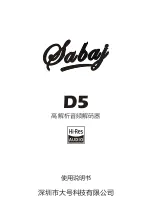
Switch mode, single-phase, sine-wave Inverter
Product line TEBEVERT
August 8, 2005 - DTL
17/21
No. 4219en R2
All connections are carried out at the rear of the inverter. (See Figure 4 and block
diagram / appendix A)
1)
Connect the personnel safety ground conductor to the appropriate
marked studs.
•
Cable cross section: 10 AWG – 6 AWG, maximum
•
Connection via two hole lugs (1/4” x 5/8”) suitable for the cable cross
section
•
Nominal range of tightening torque: ( 4,5 – 6 ) Nm, use 10mm socket
wrench.
2)
Connect the DC-supply conductor to the CU-bars X1(+) and X1(-)
Attention!
Ensure correct polarity
•
Cable cross section: 10 AWG – 6 AWG, maximum
•
Connection via two hole lugs (1/4” x 5/8”) suitable for the cable cross
section
•
Recommended protection device: 25A Fuse or Circuit Breaker
•
Nominal range of tightening torque: ( 4,5 – 6 ) Nm, use 10mm socket
wrench.
3)
Plug customer load into receptacle X3; X4 (NEMA 5-15 R )
4)
Optional - Plug Commercial AC bypass (if required) into the inlet X2
(IEC/EN 60320-1) Benning Pt. No. 220-1000-102, IEC-320-14 line
cord, 7’-6” long.
5)
Connect the potential free central alarm to X5;1, 2 or 3 as required,
screw terminals (M2)
•
Cable cross section: 28 AWG – 16 AWG
•
Max load: 160VAC / 8A
•
Max. Fusing, if required: depends on the cross section of the cable
used; see appropriate local codes (e.g. NEC)
•
Nominal range of tightening torque: (0,22 – 0,25) Nm
Attention!
Only CU-conductors should be used.
All connecting cables must be provided with appropriate strain
relief. (see appropriate national standards; e.g. NEC )






































